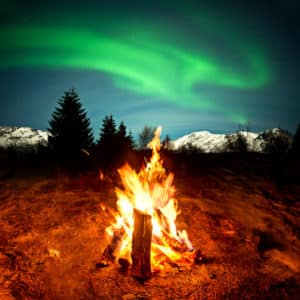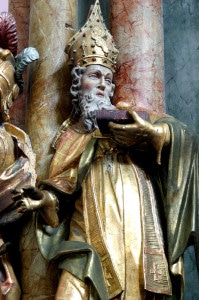Winter Solstice and Holiday Celebrations in History
In our home town, we celebrate the Holidays with many traditions. Some cultural, some based in religion, most celebrating the love of family and home. Holiday celebrations in history and winter solstice have been tied together for centuries.
Many of us dream of a roaring fire, the intoxicating scent of pine and cookies in the air, and magical lights dancing on homes enveloped in a soft and sparkling blanket of new snow.
Before early Christians adopted what was then called ‘The Feast of Nativity’ somewhere around 400 AD, celebrations were held in the middle of winter to mark the passing of the ‘darkest days’ and express joy that extended hours of sunlight and warmer weather were coming. There was good reason to celebrate –longer days and warmth meant easier access to food.
These celebrations occurred several centuries BC. Scandinavian history shows that the Norse began their Yule traditions at winter solstice. In honor of the returning sun, large logs were set afire. These could take as long as two weeks to burn, during which people feasted (and presumably drank copious amounts of grog). The Norse believed that each spark from the fire was a sign that a new pig or calf would be born in the coming spring.
During this time, people in Germany were not quite as joyful. They honored the pagan god Woden (Odin in Norse mythology) during mid-winter. Woden was terrifying – he was said to fly through the town in the night to decide who would prosper or perish. Most people wisely chose to stay indoors to avoid being seen by Woden, who rode an eight-legged horse by the name of Sleipnir and kept company with dead warriors.
Ancient Romans celebrated Saturnalia around the time of winter solstice. The Saturnalia festival, named for the Roman god Saturn, involved much revelry, including feasting, bonfires, decorating with evergreens, and giving gifts. Much like the Norse Yule celebration, Saturnalia also included extended periods of drunkenness – the festival began the week prior to winter solstice and lasted a full month.
It is generally accepted by historians that Pope Julius I, the Bishop of Rome from AD337 to 352, chose December 25th as the day of the ‘Feast of the Nativity’ celebration largely in an effort to adopt and absorb the pagan traditions of Saturnalia. By the end of the eighth century, the celebration of ‘Christmas’ had spread all the way to Scandinavia.
But people weren’t so eager to give up their wild celebrations. During the Middle Ages, many attended church services followed by a raucous and carnival-like party much like today’s Mardi Gras.
The addition of Santa Claus to the Christmas celebrations began with Saint Nicholas of Myra, a 4th century Greek Christian bishop in what now is Turkey. He was famous for his generous gifts to the poor. Early depictions of Santa Claus in Europe typically showed him  as a bearded bishop in canonical robes, although his persona became more serious and overbearing than the original Saint. Many drawings show St. Nicholas as a frightening man holding a birch rod, who had the power to know and see all, which is likely where ‘he knows if you’ve been naughty or nice’ came from.
as a bearded bishop in canonical robes, although his persona became more serious and overbearing than the original Saint. Many drawings show St. Nicholas as a frightening man holding a birch rod, who had the power to know and see all, which is likely where ‘he knows if you’ve been naughty or nice’ came from.
In the 17th Century, Christmas took on a more religious tone in Europe. When Oliver Cromwell and his Puritan followers controlled England in the 1600’s, they vowed to abolish Christmas. This was not a popular decision, a problem which was rectified as soon as Charles II was restored to the throne.
Even our Pilgrims had some issues with the Christmas celebrations. Many were orthodox Puritans. Christmas was outlawed in Boston for nearly 22 years starting in 1659. Christmas was not declared a national holiday until 1870 in the United States.
Today, we enjoy a more all-embracing attitude toward other cultures holiday celebrations. Many countries have Christmas traditions that differ widely from our own. Some of the more memorable include:
- In Bolivia, Misa del Gallo, or ‘Mass of the Rooster’ is celebrated on Christmas Eve. People bring roosters to the church during midnight mass to acknowledge what they feel is an appropriate homage to the first animal to announce the birth of Jesus.
- In Poland, spiders or spider webs are popular Christmas tree decorations. According to legend, a spider wove a blanket for baby Jesus. Spiders are symbols of goodness and prosperity in Poland.
- In Holland, children are told that Santa Claus sails from Spain on the ‘day of the feast’, December 5th. They must fill their shoes with hay and sugar for his horse, which is replaced with gifts, such as candy.
- In Wales, caroling is popular and often includes a harpist. In rural villages, a Mari Lwyd (Grey Mare) portrayed by a villager, is chosen to travel around the town draped in white and carrying a horse’s skull on a long pole. Anyone who hadn’t been ‘good’ is bitten by the horse’s jaws and must pay a fine. The trek of the Mari Lwyd is thought to bring good luck
Here in our community? We don’t often decorate our trees with spider webs, wear horse skulls while caroling, or bring roosters to church. Most of us enjoy the love of good friends and closeness of family. We bake delectable treats to share. We spend hours decorating our homes with boughs offered by nature. Each of us brings a bit of tradition lovingly handed down through the generations of our families, until we make the Holiday our own. Holiday celebrations in history and winter solstice will always be a significant way to mark the shorter days and longer nights.













